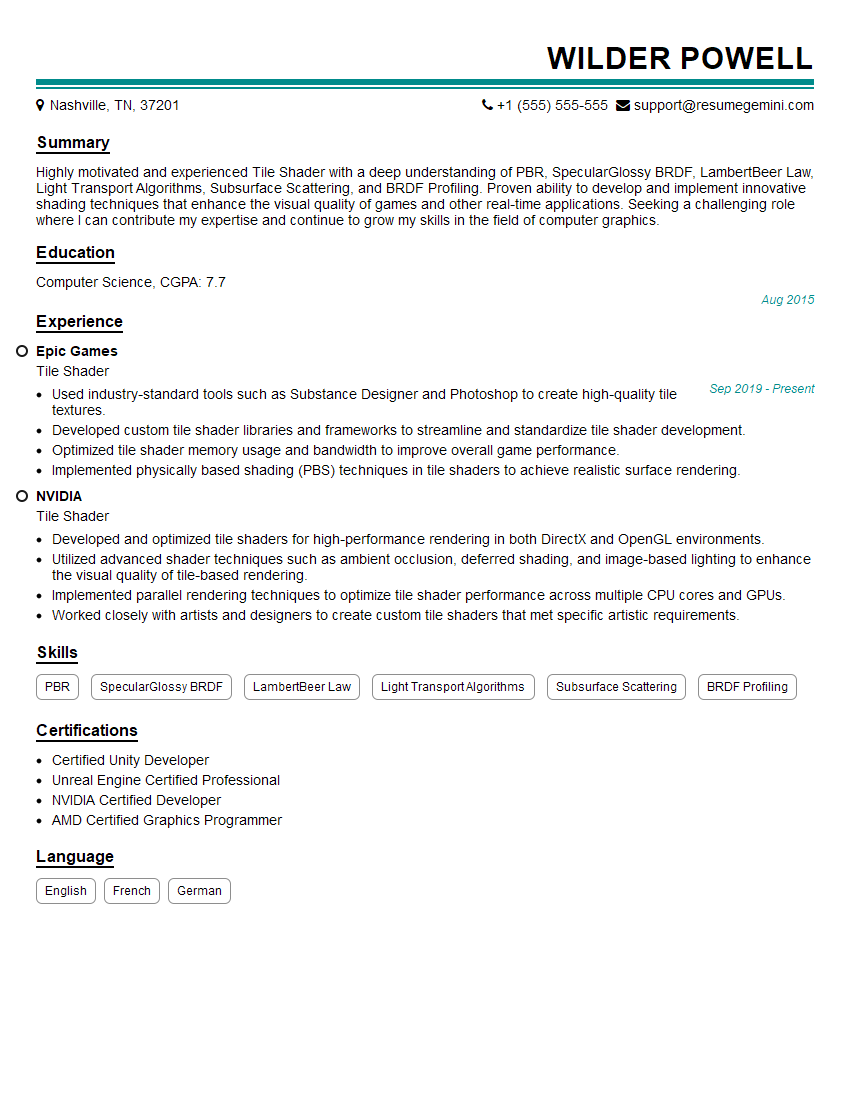Are you a seasoned Tile Shader seeking a new career path? Discover our professionally built Tile Shader Resume Template. This time-saving tool provides a solid foundation for your job search. Simply click “Edit Resume” to customize it with your unique experiences and achievements. Customize fonts and colors to match your personal style and increase your chances of landing your dream job. Explore more Resume Templates for additional options.

Wilder Powell
Tile Shader
Summary
Highly motivated and experienced Tile Shader with a deep understanding of PBR, SpecularGlossy BRDF, LambertBeer Law, Light Transport Algorithms, Subsurface Scattering, and BRDF Profiling. Proven ability to develop and implement innovative shading techniques that enhance the visual quality of games and other real-time applications. Seeking a challenging role where I can contribute my expertise and continue to grow my skills in the field of computer graphics.
Education
Computer Science
August 2015
Skills
- PBR
- SpecularGlossy BRDF
- LambertBeer Law
- Light Transport Algorithms
- Subsurface Scattering
- BRDF Profiling
Work Experience
Tile Shader
- Used industry-standard tools such as Substance Designer and Photoshop to create high-quality tile textures.
- Developed custom tile shader libraries and frameworks to streamline and standardize tile shader development.
- Optimized tile shader memory usage and bandwidth to improve overall game performance.
- Implemented physically based shading (PBS) techniques in tile shaders to achieve realistic surface rendering.
Tile Shader
- Developed and optimized tile shaders for high-performance rendering in both DirectX and OpenGL environments.
- Utilized advanced shader techniques such as ambient occlusion, deferred shading, and image-based lighting to enhance the visual quality of tile-based rendering.
- Implemented parallel rendering techniques to optimize tile shader performance across multiple CPU cores and GPUs.
- Worked closely with artists and designers to create custom tile shaders that met specific artistic requirements.
Certificates
- Certified Unity Developer
- Unreal Engine Certified Professional
- NVIDIA Certified Developer
- AMD Certified Graphics Programmer
Languages
- English
- French
- German
Career Expert Tips:
- Select the ideal resume template to showcase your professional experience effectively.
- Master the art of resume writing to highlight your unique qualifications and achievements.
- Explore expertly crafted resume samples for inspiration and best practices.
- Build your best resume for free this new year with ResumeGemini. Enjoy exclusive discounts on ATS optimized resume templates.
How To Write Resume For Tile Shader
- Read the job description carefully and tailor your resume to the specific requirements of the role.
- Highlight your skills and experience in tile shading, PBR, and other relevant areas.
- Include a portfolio of your work to showcase your abilities.
- Quantify your accomplishments whenever possible, using specific metrics to demonstrate the impact of your work.
Essential Experience Highlights for a Strong Tile Shader Resume
- Develop and implement tile-based shading algorithms for real-time rendering.
- Optimize tile shaders for performance and quality.
- Investigate and implement new shading techniques and technologies.
- Work with other engineers to integrate tile shaders into the rendering pipeline.
- Provide technical support to game developers and artists.
- Participate in research and development projects to advance the state of the art in real-time rendering.
Frequently Asked Questions (FAQ’s) For Tile Shader
What is a tile shader?
A tile shader is a fragment shader that operates on a small region, or tile, of a larger image. Tile shaders are typically used in real-time rendering to improve performance by reducing the amount of data that needs to be processed by the GPU.
What are the benefits of using tile shaders?
Tile shaders can provide several benefits, including improved performance, reduced memory usage, and increased flexibility. By operating on smaller tiles, tile shaders can reduce the amount of data that needs to be processed by the GPU, which can lead to significant performance improvements.
What are some of the challenges of developing tile shaders?
Developing tile shaders can be challenging, as it requires a deep understanding of the rendering pipeline and the underlying hardware. Additionally, tile shaders can be difficult to debug, as they can be affected by a variety of factors, such as the size of the tile, the data layout, and the shader code itself.
What are some of the applications of tile shaders?
Tile shaders are used in a variety of applications, including real-time rendering, image processing, and video editing. In real-time rendering, tile shaders are used to create complex and realistic scenes. In image processing, tile shaders are used to apply filters and effects to images. In video editing, tile shaders are used to create transitions and other effects.
What are some of the future trends in tile shader development?
Some of the future trends in tile shader development include the use of artificial intelligence to automate the generation of tile shaders, the development of new tile shader algorithms that are more efficient and flexible, and the use of tile shaders in new applications, such as augmented reality and virtual reality.